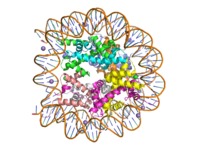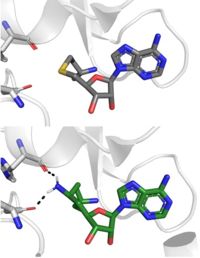User:Lauryn Padgett/Sandbox 1
From Proteopedia
(Difference between revisions)
| Line 12: | Line 12: | ||
==Lysine Methyltransferase (KMT) Structure== | ==Lysine Methyltransferase (KMT) Structure== | ||
| - | The structure of human histone methyltransferase SET7/9 was crystallized | + | The structure of human histone methyltransferase SET7/9 was crystallized via X-ray diffraction at 1.75Å using the products of its normal reaction.<ref name="Xiao" />. Therefore, the unmethylated form of its cofactor, <scene name='81/811086/Sah/1'>S-adenosyl-L-homocysteine</scene> (SAH), was used along with an example of a possible <scene name='81/811086/10resproduct/1'>product</scene>, a ten residue peptide with a lysine methylated at residue position 4. The PDB code for the crystallized SET7/9 structure is 1O9S. |
===Overall Secondary Structure=== | ===Overall Secondary Structure=== | ||
| - | Due to the composition of its [https://en.wikipedia.org/wiki/Protein_secondary_structure secondary structure], KMT is an | + | Due to the composition of its [https://en.wikipedia.org/wiki/Protein_secondary_structure secondary structure], KMT is an ά-β protein <ref name="Xiao" />. The helical composition includes 3 <scene name='81/811086/Alpha_helices/4'>alpha helices</scene>, with two located in the SET domain and one in the C-terminal domain. The alpha helices in the SET domain are both two turns while the C-terminal alpha helix is the largest with 4 turns. There are also 2 <scene name='81/811086/3-10_helices/4'>3-10 helices</scene> in the SET domain which are each one turn. There protein's <scene name='81/811086/Beta_sheets/3'>beta strands</scene> reside in both the N-terminal domain and the SET domain and total 21. The beta strands are primarily anti-parallel and multiple antiparallel strands are connected by Type 1 and Type 2 <scene name='81/811086/Beta_turns/3'>beta turns</scene>. |
===The Active Site=== | ===The Active Site=== | ||
Revision as of 22:26, 26 April 2019
Histone Lysine Methyltransferase: Gene Activator
| |||||||||||
References
- ↑ DesJarlais R, Tummino PJ. Role of Histone-Modifying Enzymes and Their Complexes in Regulation of Chromatin Biology. Biochemistry. 2016 Mar 22;55(11):1584-99. doi: 10.1021/acs.biochem.5b01210. Epub , 2016 Jan 26. PMID:26745824 doi:http://dx.doi.org/10.1021/acs.biochem.5b01210
- ↑ 2.0 2.1 doi: https://dx.doi.org/10.1016/j.apsb.2013.04.007
- ↑ 3.0 3.1 Dong X, Weng Z. The correlation between histone modifications and gene expression. Epigenomics. 2013 Apr;5(2):113-6. doi: 10.2217/epi.13.13. PMID:23566087 doi:http://dx.doi.org/10.2217/epi.13.13
- ↑ 4.0 4.1 Del Rizzo PA, Trievel RC. Substrate and product specificities of SET domain methyltransferases. Epigenetics. 2011 Sep 1;6(9):1059-67. doi: 10.4161/epi.6.9.16069. Epub 2011 Sep, 1. PMID:21847010 doi:http://dx.doi.org/10.4161/epi.6.9.16069
- ↑ 5.0 5.1 5.2 5.3 5.4 5.5 5.6 5.7 Xiao B, Jing C, Wilson JR, Walker PA, Vasisht N, Kelly G, Howell S, Taylor IA, Blackburn GM, Gamblin SJ. Structure and catalytic mechanism of the human histone methyltransferase SET7/9. Nature. 2003 Feb 6;421(6923):652-6. Epub 2003 Jan 22. PMID:12540855 doi:10.1038/nature01378
- ↑ 6.0 6.1 6.2 Takemoto Y, Ito A, Niwa H, Okamura M, Fujiwara T, Hirano T, Handa N, Umehara T, Sonoda T, Ogawa K, Tariq M, Nishino N, Dan S, Kagechika H, Yamori T, Yokoyama S, Yoshida M. Identification of Cyproheptadine as an Inhibitor of SET Domain Containing Lysine Methyltransferase 7/9 (Set7/9) That Regulates Estrogen-Dependent Transcription. J Med Chem. 2016 Apr 28;59(8):3650-60. doi: 10.1021/acs.jmedchem.5b01732. Epub, 2016 Apr 18. PMID:27088648 doi:http://dx.doi.org/10.1021/acs.jmedchem.5b01732
- ↑ Tamura R, Doi S, Nakashima A, Sasaki K, Maeda K, Ueno T, Masaki T. Inhibition of the H3K4 methyltransferase SET7/9 ameliorates peritoneal fibrosis. PLoS One. 2018 May 3;13(5):e0196844. doi: 10.1371/journal.pone.0196844., eCollection 2018. PMID:29723250 doi:http://dx.doi.org/10.1371/journal.pone.0196844
Student Contributors
Lauryn Padgett, Alexandra Pentala, Madeleine Wilson




